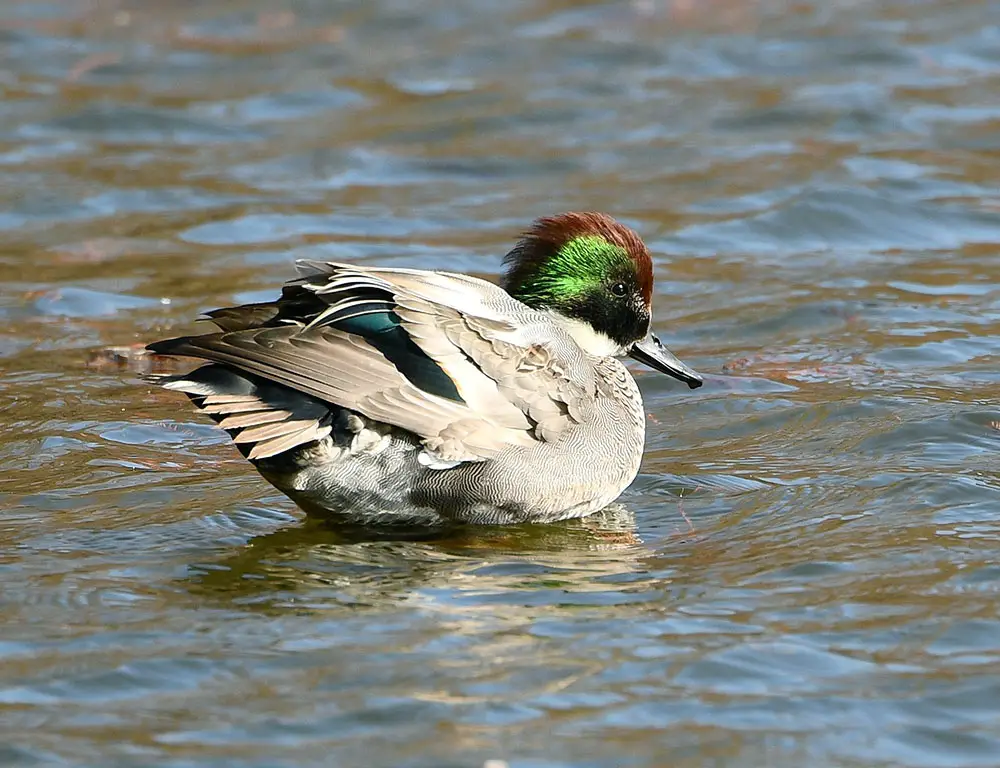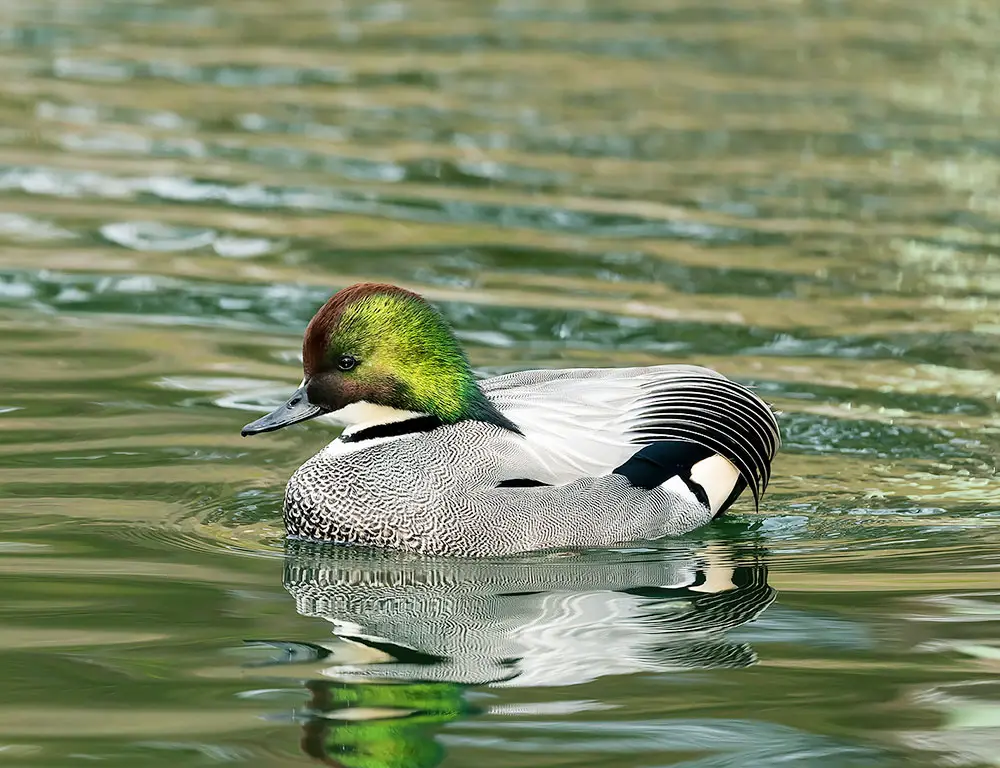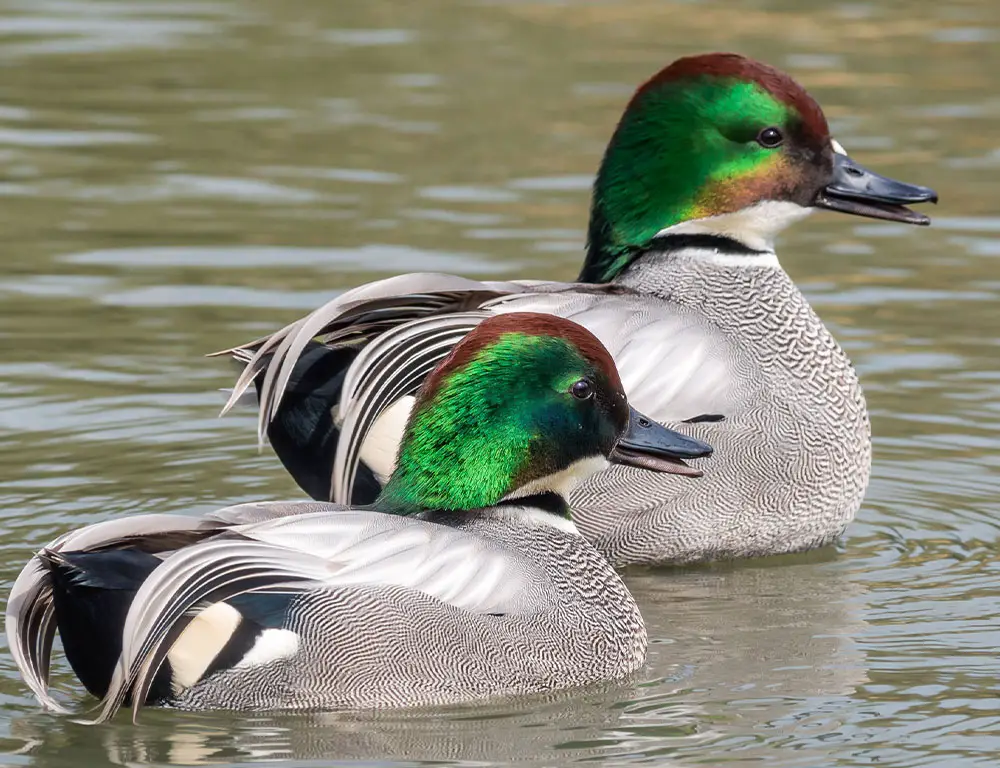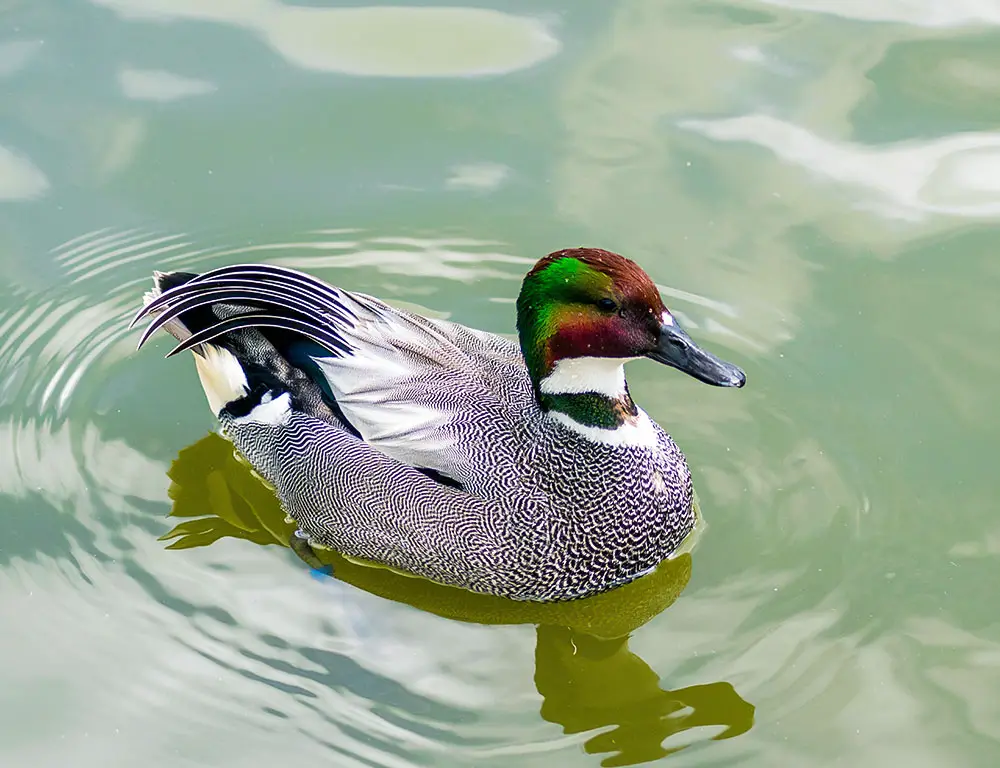The Falcated Duck is a hidden gem of nature with its captivating beauty and unique features. Named for its distinctive falcated feathers, this waterfowl species native to eastern Asia exhibits stunning plumage that glimmers in sunlight.
Males boast iridescent green heads, cinnamon-colored necks, and intricately patterned grey bodies, while females exude elegance.
Thriving in wetlands and freshwater lakes, these ducks showcase remarkable adaptability as skilled swimmers and divers.
However, their existence is threatened by habitat loss and hunting pressures, highlighting the fragility of our planet’s biodiversity.
As stewards of nature, it’s imperative to recognize the significance of conserving species like the Falcated Duck and safeguarding their habitats for future generations.

Physical Characteristics of Falcated Duck
The physical characteristics of the Falcated Duck are genuinely remarkable and set it apart from other duck species. Here’s a summary of its key features:
Coloration
- Males: During the breeding season, male Falcated Ducks exhibit iridescent green heads that shimmer in the sunlight.
They also have cinnamon-colored necks and intricately patterned grey bodies. Their elongated outer tail feathers, known as “falcations,” are sickle-shaped and display a bronze strip. - Females: Females have a more subdued coloration than males, with overall brownish-grey plumage interspersed by lighter streaks. While not as vibrant as males, their elegance is undeniable.
Size and Shape
- Size: Falcated Ducks are medium-sized waterfowl. On average, males can reach lengths of 20-25 inches, while females are slightly smaller at 18-22 inches.
- Shape: They have medium-sized bodies with relatively long necks and a broad, spatulate bill characteristic of dabbling ducks. Their wingspan measures between 30-33 inches for both sexes.
Tail Feathers
Falcated Ducks have unique tail feathers that give them their name. The outer tail feathers are elongated and sickle-shaped, tapering to a point. These feathers have a black base that gradually fades into white towards the end.
Weight
Males typically weigh between 1.5 to 2 pounds, while females weigh slightly less, ranging from 1 to 1.5 pounds.
Sexual Dimorphism
While there are differences in coloration and size between males and females, the degree of sexual dimorphism in Falcated Ducks is not as pronounced as in other waterfowl species. Both genders share similar body proportions and general appearance.
Habitat and Distribution of Falcated Duck

The Falcated Duck (Mareca falcata) inhabits a range of wetland habitats and exhibits a specific distribution pattern. Here’s an overview of its habitat and distribution:
Habitat
Falcated Ducks are primarily found in freshwater wetlands, including lakes, marshes, rivers, and ponds. They prefer habitats with dense vegetation, which provides cover for nesting and feeding.
These wetlands often have abundant aquatic plants and insects, which form the primary food source for Falcated Ducks. Suitable nesting sites are typically located among tall grasses near water bodies, protecting breeding pairs and their offspring.
Distribution
The distribution of Falcated Ducks spans several regions, with a primary focus on eastern Asia. Key areas include:
- Breeding Grounds: Falcated Ducks breed in regions such as eastern Russia, northeastern China, and parts of North Korea. These areas provide suitable breeding habitats with freshwater lakes and marshes surrounded by vegetation.
- Migration Routes: During migration, Falcated Ducks travel from their breeding grounds to wintering sites in warmer regions. Wintering grounds include Japan, South Korea, Taiwan, northern India, and Bangladesh.
Some individuals may also migrate to Western Europe, including France, and occasionally appear along North America’s Pacific coast, particularly in California. - Native Range: The native range of Falcated Ducks primarily encompasses eastern Asia, where they are most commonly found. However, sightings outside of their native range are considered rare, with most of the population concentrated east of Asia.
Behavior and Diet of Falcated Duck

The behavior and diet of the Falcated Duck (Mareca falcata) provide fascinating insights into the lifestyle of this species. Here’s an overview:
Feeding Habits
Falcated Ducks are primarily herbivorous, feeding on a diet consisting mainly of plant matter. Their meals often include seeds, aquatic plants, grains, and algae.
Additionally, they may consume small insects and crustaceans when available in their environment.
They use a feeding method known as dabbling, where they dip their bills into shallow water to reach food resources at various depths. They may also upend, with their tail feathers in the air and head underwater, to access food.
Social Interactions
Falcated Ducks exhibit both sociable and territorial behaviors depending on the season. During migration and wintering periods, they can form large flocks numbering over 100 individuals.
However, during the breeding season, male Falcated Ducks become highly territorial, defending specific areas against other males seeking to establish nesting sites or mates.
Outside of the breeding season, they generally exhibit peaceful behavior and prefer to flock together rather than engage in territorial disputes.
Breeding Behavior
Breeding season for Falcated Ducks typically occurs from April to June. Mating pairs migrate together to breeding grounds, where females lay an average of 6-10 eggs in nests constructed among tall grass near water bodies.
The female is responsible for incubating the eggs while the male guards the nest perimeter, ensuring safety from potential predators. Falcated Ducks emit soft whistles (males) and low quacks (females) during courtship and when threatened.
Migration
Falcated Ducks are migratory birds, traveling long distances between their breeding and wintering grounds.
They undertake southward migrations from their breeding grounds in eastern Asia to wintering sites in regions such as Japan, South Korea, Taiwan, northern India, and Bangladesh.
They may also make rare appearances along the Pacific coast of North America, particularly in California. Weather patterns influence their migration, and they rely on their sleek body design and strong wing muscles to fly at high speeds over extended periods.
Conservation Status of Falcated Duck

The conservation status of the Falcated Duck (Mareca falcata) is currently categorized as “Least Concern” by the International Union for Conservation of Nature (IUCN).
However, despite this classification, the species faces several threats that warrant attention and conservation efforts.
Here’s an overview of its conservation status and associated challenges:
Threats
The Falcated Duck faces several significant threats to its survival and population stability. These threats include:
Habitat Loss
One of the primary threats to Falcated Ducks is habitat loss and degradation. Wetlands, lakes, and marshes, vital habitats for these ducks, are increasingly being drained or converted for agriculture, urban development, and other human activities.
Loss of suitable breeding and foraging habitats can significantly impact the population and distribution of Falcated Ducks.
Climate Change
Climate change poses a growing threat to Falcated Ducks and their habitats. Altered weather patterns, rising temperatures, and changes in precipitation can disrupt migratory routes, breeding cycles, and food availability.
Additionally, rising sea levels and extreme weather events can further impact wetland habitats, which are essential for the survival of these ducks.
Hunting
Illegal hunting and poaching remain significant threats to Falcated Ducks, particularly in areas where they are hunted for food or sport.
Despite legal protections in some regions, enforcement of hunting regulations may need to be improved, leading to unsustainable harvest levels and population declines.
Conservation Efforts
Despite these challenges, there are ongoing conservation efforts aimed at mitigating threats and ensuring the survival of Falcated Ducks:
Protected Areas
Establishing and effectively managing protected areas is crucial for conserving Falcated Duck habitats.
Wetland reserves, national parks, and wildlife sanctuaries can provide refuge for these ducks and other waterfowl species, safeguarding critical breeding, wintering, and stopover sites along migration routes.
Habitat Restoration
Implementing wetland restoration projects can help restore degraded habitats and improve the quality of breeding and foraging areas for Falcated Ducks.
Restoring natural hydrological processes, controlling invasive species, and enhancing habitat connectivity can improve the resilience of wetland ecosystems and support healthy duck populations.
Law Enforcement
Strengthening enforcement of hunting regulations and implementing measures to combat illegal hunting and poaching are essential for protecting Falcated Ducks from overexploitation.
Increasing surveillance, imposing penalties for wildlife crimes, and raising awareness about the importance of conservation can help reduce hunting pressure on duck populations.
Research and Monitoring
Researching Falcated Duck populations, behavior, and habitat requirements is essential for informed conservation decision-making.
Monitoring population trends, tracking migration routes, and assessing the impacts of environmental threats can guide targeted conservation interventions and ensure the long-term survival of these ducks.
FAQs
What is the migratory behavior of Falcated Ducks?
Falcated Ducks are migratory birds, traveling from breeding grounds in eastern Asia to wintering sites in warmer regions. They undertake long-distance journeys, with migration typically occurring in the autumn and spring months.
How do Falcated Ducks communicate?
Falcated Ducks emit soft whistles (males) and low quacks (females) during courtship and when threatened. They may also use body language and vocalizations to communicate within their flock.
What is the lifespan of a Falcated Duck?
The lifespan of a Falcated Duck in the wild is typically around 5-10 years, although some individuals may live longer in favorable conditions.
Are Falcated Ducks social birds?
Yes, Falcated Ducks are social birds, often forming large groups during migration and wintering periods. However, they may become territorial during the breeding season, defending nesting sites and mates against intruders.
Do Falcated Ducks have any natural predators?
Falcated Ducks face predation from various predators, including birds of prey such as eagles and hawks, mammals like foxes and raccoons, and large fish and reptiles that inhabit their wetland habitats.
Conclusion
The Falcated Duck is a captivating emblem of nature’s resilience and beauty despite facing significant threats such as habitat loss, hunting pressure, and climate change.
With an estimated global population of 89,000 to 110,000 individuals, primarily concentrated in Asia, the species remains a rare sight in other regions. Yet, its striking appearance and unique behaviors fascinate bird enthusiasts worldwide.
As stewards of the natural world, it’s imperative that we deepen our understanding of these remarkable creatures and actively participate in their conservation.
Let us strive to preserve the habitats and ecosystems upon which the Falcated Duck and countless other species depend, ensuring their legacy for future generations.